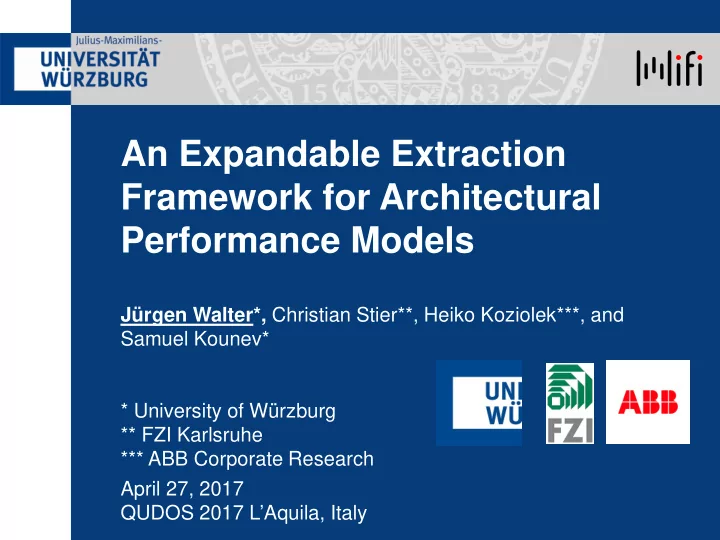

An Expandable Extraction Framework for Architectural Performance Models Jürgen Walter*, Christian Stier**, Heiko Koziolek***, and Samuel Kounev* * University of Würzburg ** FZI Karlsruhe *** ABB Corporate Research April 27, 2017 QUDOS 2017 L’Aquila, Italy
Motivation Architectural models can be applied for design time analysis and reconfigurations at runtime … Jürgen Walter 4/27/2017 2
Motivation Manual creation Performance Engineer … Huge effort per Architectural application Performance Model Jürgen Walter 4/27/2017 3
Motivation Automated model learning Components, controlflow, resource demands, workload, … Performance Engineer … Huge effort for each Architectural formalism Performance Model Jürgen Walter 4/27/2017 4
Problem Statement Analysis Toolchain Parallelism As a user, I would like to use different analysis approaches in parallel. Analysis Toolchain Flexibility As a user, I prefer not to be forced to decide about the toolchain in advance. Extraction Toolchain Reuse As a user, I would like to include performance model extraction for newly emerging formalisms without bothering about extraction complexity. Performance Engineer Jürgen Walter 4/27/2017 5
Idea Decouple learning of generic aspects from object creation routines Performance Engineer … Automated learning of generic aspects Architectural Performance Model Jürgen Walter 4/27/2017 6
Two step model learning 1. learning of generic aspects 2. model element creation Jürgen Walter 4/27/2017 7
Approach Develop a framework that provides developers with a solution that integrates established tooling for monitoring, log processing, and resource demand estimation. To leverage the framework for model construction developers only have to implement a model builder interface that maps language independent concepts to language specific representations. Jürgen Walter 4/27/2017 8
Learning of generic aspects PMX internaly uses a pipes and filter architecture PMX reuses existing libraries were possible • Resource demands • Operation call graph • Resource landscape • Deployment • Job arrival rates Jürgen Walter 4/27/2017 9
Approach * PerformanceModelExtractor Builder PalladioBuilder PalladioModel builder:Builder buildPart() construct() DMLBuilder DMLModel this.builder.buildPart() creates Decouple learning and model creation using builder pattern Jürgen Walter 4/27/2017 10
Builder Interface The interface includes object creation routines … public EObject createHost(String hostName, int numberOfCores); public EObject createComponent(String componentName); public EObject createInterface(String InterfaceName); // public EObject createMethod(String interfaceName, Signature signature); public EObject createAssembly(String assemblyName, String componentName); public EObject createAllocation(String assemblyName, String hostName); // public EObject createProvidedRole(String componentName, String interfaceName); public EObject createRequiredRole(String componentName, String interfaceName); public EObject createServiceBehavior(String componentName, String methodName, List<ExternalCall> externalCalls, String processingResource, double meanResourceDemand);// public void createResourceDemand(String service);// public void createWorkload(HashMap<String, List<Double>> workload); Jürgen Walter 4/27/2017 11
Builder Interface II …and getter and connector functions Meta-model elements have cross references e.g., deployment referes to infrastructure and component definitions public EObject getRole(String role); public EObject getAssembly(String assemblyName); public EObject getMethod(String methodName); public EObject getInterface(String interfaceName); public EObject getServiceBehavior(String componentName,String methodName); … Implementation of getters can be alleviated inheriting from a provided AbstractBuilder class that stores created elements into HashMaps Jürgen Walter 4/27/2017 12
Evaluation Setting Pet Clinic application Deployed on a 42 core VM Web & Application Server WelcomeController Welcome HTTP Controller VetControllerHTTP VetController OwnerController Owner Vet HTTP Controller VetRepository ClinicServiceImpl Owner Repository Database PetClinic- CacheConfig Application Admin Jürgen Walter 4/27/2017 13
Evaluation Results Deviation for utilization is below 2% and below 10% for response times. Jürgen Walter 4/27/2017 14
Related Work Automated model extraction approaches Closed source: PMW, Epasa limited to a single modeling language Subparts of model learning Extraction of resource demands, e.g., LibEeDE (Spinner2014, Spinner2015) Flexibility Intermediate models (PMIF, Klapper, CSM,…) Generic meta-model (SAMM) Interchange format (DUALLY) Jürgen Walter 4/27/2017 15
Available online PMX core as well as builders are available online http://descarte.tools/pmx/ Jürgen Walter 4/27/2017 16
Future Work Provide more builder implementations Conduct more case studies Allow for different monitoring tools and formats using OPEN.xtrace (formerly Common Trace API (CTA)) as input Use extracted models … to integrate in load testing e.g., using a Jenkins plugin for runtime resource management Jürgen Walter 4/27/2017 17
Conclusion We present a framework for the extraction of architectural performance models generalizing over the target modeling language. Using the presented approach, the user only has to implement our builder interface to create a performance model generation tool for a specific modeling language. Jürgen Walter 4/27/2017 18
Thank You! Jürgen Walter*, Christian Stier**, Heiko Koziolek***, and Samuel Kounev* * University of Würzburg ** FZI Karlsruhe *** ABB Corporate Research April 27, 2017 QUDOS 2017 L’Aquila, Italy
Recommend
More recommend